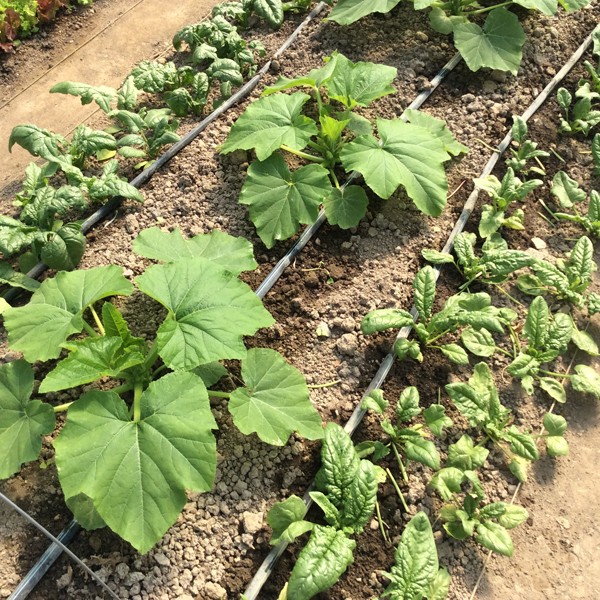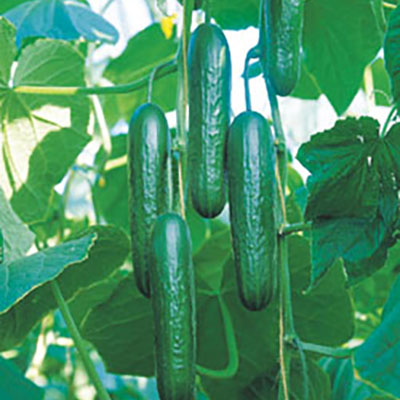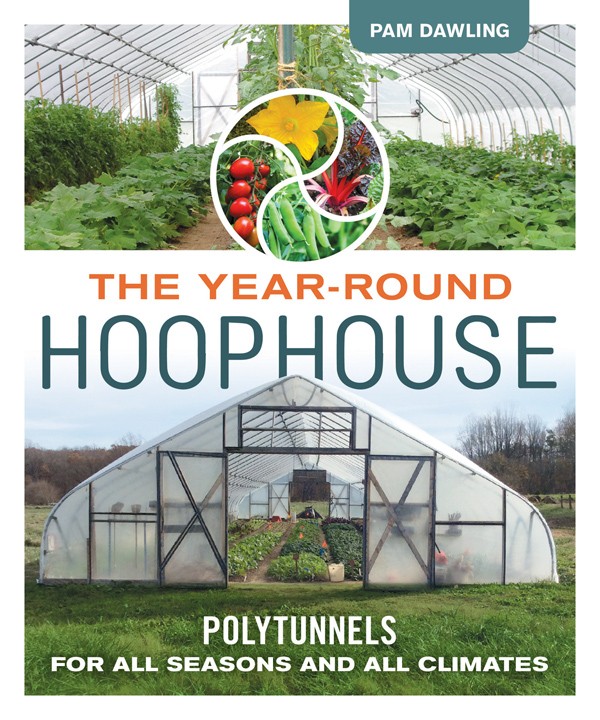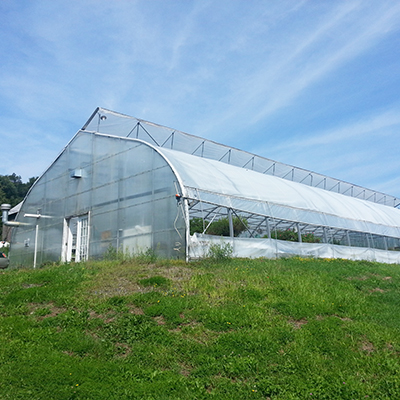I’ve often wondered why more market growers don’t use umbrella pruning for greenhouse and hoophouse cucumbers. It’s probably the most common way of growing cukes in greenhouses, and translates well to hoophouses and smaller structures with trellising in the 6-7’ range. I’m pretty sure the reason it’s not used more is unfamiliarity, since most smaller growers I’ve talked with don’t know about it. It’s called umbrella style because the main stem is grown up a string (the umbrella handle), topped at the wire, and two suckers are allowed to grow out to each side (the umbrella canopy).
One of the difficulties of growing cucumbers in a confined space is that they grow so fast, they rapidly fill up the space and crowd each other. The umbrella method solves this problem by topping the plants when they reach the trellis wire, allowing side branches (a.k.a. suckers or laterals) to fill the space between plants and bear most of the fruit. After the plants are topped, there is almost no more pruning necessary during the harvest stage.
This short article is adapted from my new book, The Greenhouse and Hoophouse Grower’s Handbook. Growing umbrella cukes comes down to spacing and pruning, as all the other details (propagation, variety selection, temperature, harvest, pests and diseases etc.) are the same as in other methods for growing protected cukes.
Below, umbrella cukes growing in a greenhouse. These young plants have just reached the top wire and are soon to be topped. Photo by Andrew Mefferd.

Spacing
Most umbrella cucumbers are planted in double rows 2’ apart, with 3’ between plants in the row, and a 3’ walkway. Or you can plant a single row 1.5’ apart, and train every other plant to opposite sides of the double row. The advantage to planting a single row is ground cover can be pulled up close on either side of the row, leaving very little area exposed for weeds to grow. Either way, you need two trellis wires or pipes two feet apart above the crop to tie trellis strings to.
Top box in the diagram below shows how plants are spaced three feet apart in the row, and the laterals grow over the trellis wire until they meet the laterals from the next plant. The bottom box shows an overhead veiw of how planting can be done in double rows 2’ apart with plants 3’ apart in the row (green dots), or in a single row down the middle of the bed with plants 1.5’ apart in the row (red dots).

Pruning and trellising
One piece of twine per plant is tied to the overhead wire. The vine is grown up the twine by twisting or clipping, removing suckers on a regular basis as the vine grows up.
After pruning large-fruited cukes off the initial two feet of stem, let a cuke develop at every other node up to the wire. As the plants approach the top wire, make sure and leave the three suckers immediately below the wire. You really only need two (one for each side of the plant), but leave an extra in case one of them gets damaged, you’ll still have two left. Let these three suckers grow and as the head of the plant grows, cut it off just above the wire. Topping the plant will push the energy that was going to the head to the suckers left on the plant.
These first laterals to grow out from the main stem are called the primary laterals. When the primary laterals are roughly 1-2’ long (long enough to drape over the wire and stay in place), guide them over the wire. The idea is for the laterals (and all the fruit on them) to pull down on the wire, instead of pulling the main stem back down the string. Once each plant has one lateral per side safely over the wire, you can prune off the third lateral.
At this point, you’re almost done pruning. Don’t prune the suckers from the primary laterals. The suckers grow into the secondary laterals, where most of the fruit is set. When the primary laterals grow down to about chest height (when they meet the primary lateral from the next plant), pinch the tips off to stop their growth and you’re done pruning.
Secondary laterals and cucumbers will continue forming on the primary laterals through the productive life of the plant. Umbrella trellising essentially turns the cucumber vine into a determinate by limiting its upward growth. The plant will only remain productive for so long after being topped. Some growers decide to germinate the next crop when they notice yield from the first crop slowing down, while others start plants on a fixed schedule with each crop lasting for 3-4 months of picking.
For more on growing cukes, tomatoes, peppers, eggplant, lettuce, greens, microgreens and herbs in protected culture, read The Greenhouse and Hoophouse Grower's Handbook.

 We have three main seasons in our zone 7 central Virginia hoophouse: fall-winter (October to March), spring-early summer (March to July) and high summer (August and September). We grow one bed (90’/27.5 m or so) each of yellow squash and bush cucumbers in the spring-summer season, for reliable early harvests and to help with crop rotation. If you farm in a colder climate than ours, you might be questioning allocating the precious real estate to a crop that so quickly goes from desirable to over-abundant, especially when there are more profitable things to give the space to. One reason is a difference between southern and northern climates.
We have three main seasons in our zone 7 central Virginia hoophouse: fall-winter (October to March), spring-early summer (March to July) and high summer (August and September). We grow one bed (90’/27.5 m or so) each of yellow squash and bush cucumbers in the spring-summer season, for reliable early harvests and to help with crop rotation. If you farm in a colder climate than ours, you might be questioning allocating the precious real estate to a crop that so quickly goes from desirable to over-abundant, especially when there are more profitable things to give the space to. One reason is a difference between southern and northern climates.


 Why two of our hoophouses are named because of Emily
Why two of our hoophouses are named because of Emily
 As soon as we start driving our routes in the spring our customers ask us when we’ll have roselilies. They’re that popular and have become a signature crop for us. They’re basically a type of oriental lily, but with multiple layers of petals, and without stamens and pistils (i.e. no pollen!).
As soon as we start driving our routes in the spring our customers ask us when we’ll have roselilies. They’re that popular and have become a signature crop for us. They’re basically a type of oriental lily, but with multiple layers of petals, and without stamens and pistils (i.e. no pollen!). 


 In the hoophouse plants grow bigger and faster. We want to avoid anything that slows growth down. All that growing burns up the organic matter and nutrients in the soil at a fast rate, particularly in hot, humid climates. We need to replenish the soil more generously and more often than we do outdoors. Good soil health means having enough plant nutrients, not surplus. If you have too much soluble nitrogen (N), it can leach into the groundwater or burn up the organic matter. Using manure or compost for a nitrogen source can cause the build-up of excess phosphorus (P).
In the hoophouse plants grow bigger and faster. We want to avoid anything that slows growth down. All that growing burns up the organic matter and nutrients in the soil at a fast rate, particularly in hot, humid climates. We need to replenish the soil more generously and more often than we do outdoors. Good soil health means having enough plant nutrients, not surplus. If you have too much soluble nitrogen (N), it can leach into the groundwater or burn up the organic matter. Using manure or compost for a nitrogen source can cause the build-up of excess phosphorus (P).
 Local and organic ginger is a high-value crop that in the right market can be in high demand. Growing this tropical crop in the Midwest can be a challenge, and thus far, farmers thought they had to own a high tunnel to ensure adequate heat during the variable spring and fall seasons. High tunnel space on most farms is at a premium, so it is expensive space to devote to a long-season crop.
Local and organic ginger is a high-value crop that in the right market can be in high demand. Growing this tropical crop in the Midwest can be a challenge, and thus far, farmers thought they had to own a high tunnel to ensure adequate heat during the variable spring and fall seasons. High tunnel space on most farms is at a premium, so it is expensive space to devote to a long-season crop. 
 With protected space on the farm at a premium, we have to choose wisely when deciding which crops are worth putting under cover. We start out by deciding what to grow overall, and then deciding how much of that can fit inside structures, by doing a little revenue and profit analysis. Quickbooks is used to record sales, so it’s easy to list sales per item at the end of the year to see what brought in the most revenue. A version of that report extracted to a spreadsheet calculates profit per square foot by first subtracting the costs of plugs or bulbs, and then dividing by the cultivated area for each item.
With protected space on the farm at a premium, we have to choose wisely when deciding which crops are worth putting under cover. We start out by deciding what to grow overall, and then deciding how much of that can fit inside structures, by doing a little revenue and profit analysis. Quickbooks is used to record sales, so it’s easy to list sales per item at the end of the year to see what brought in the most revenue. A version of that report extracted to a spreadsheet calculates profit per square foot by first subtracting the costs of plugs or bulbs, and then dividing by the cultivated area for each item. 
 Prairie Garden Farm has been growing cut flowers for florists and studio designers since 2010. As we’re on an exposed hillside in west-central Minnesota, we’re dependent on protected culture to grow quality flowers. This article describes our approach – planning, financial, and operational details - that helps us make the most of our structures.
Prairie Garden Farm has been growing cut flowers for florists and studio designers since 2010. As we’re on an exposed hillside in west-central Minnesota, we’re dependent on protected culture to grow quality flowers. This article describes our approach – planning, financial, and operational details - that helps us make the most of our structures.
 When we talk about high salt levels in soils we do not mean simply sodium chloride, as we would if we complained of too much salt in our soup. “Salts” in the agricultural sense means all soluble ions or nutrients - nitrate, ammonium, potassium, calcium, magnesium, chloride and sulfate. Remember that these are essential nutrients – they are our friends. As with much in agriculture, soluble salt concentration is a matter of balance.
When we talk about high salt levels in soils we do not mean simply sodium chloride, as we would if we complained of too much salt in our soup. “Salts” in the agricultural sense means all soluble ions or nutrients - nitrate, ammonium, potassium, calcium, magnesium, chloride and sulfate. Remember that these are essential nutrients – they are our friends. As with much in agriculture, soluble salt concentration is a matter of balance.



